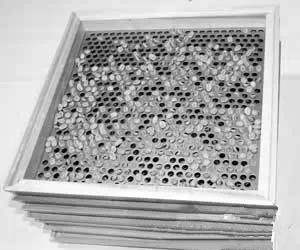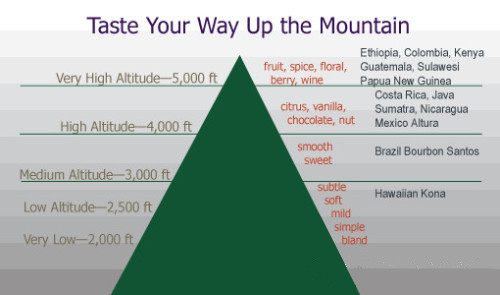Standard of coffee bean grading international standard coffee raw bean grading method
If we go to the wholesale market to buy coffee beans, we will find that the coffee beans there are generally divided into three grades: AA, A, B or AAA, AA, A. this is a simple classification for commercial use. In fact, the grading standards vary from country to country. Today, Chongqing Beresta baristas training School introduces some common ways of grading raw coffee beans to friends:

1. Graded by the size of coffee beans
Representative countries: Kenya, Papua New Guinea, Zimbabwe, Tanzania, Uganda, etc.
Coffee beans from the same origin must be large and full, which means that the coffee fruit is picked only when it grows to its best condition, and the beans in the coffee fruit can reflect the best flavor.
This grading is achieved through a sieve, where the coffee beans are placed on the sieve. After shaking back and forth, the beans smaller than the mesh are screened out, and the beans are screened again with a smaller sieve, so that after layers of selection, the coffee beans can be graded. The mesh size is calculated in 1 stroke 64 inches, the number is 19 if the diameter is 19ax 64 inches, and the number is 16 if the mesh is 16 picks 64 inches. Pingdou 20-19 is extra-large, 18 is large, 17 is quasi-large, 16 is ordinary, 15 is medium, 14 is small, and 13-12 is super-small.
According to size, it is finally divided into AA, A, B, C and PH levels, with AA as the highest level, and coffee beans at this level are eligible to be selected for selection of coffee, and coffee below C is usually used as feed or fertilizer.

two。 Grading according to the number of defective beans
Representative countries: Brazil, Indonesia, Ethiopia, Cuba, Peru, etc.
The method is to randomly take 300g samples and put them on black paper, and different defects correspond to different points, such as 1 point for 1 pebble, 5 points for 1 big pebble, 1 point for 5 broken beans and 1 point for 5 pest beans. Finally, it is graded according to the accumulated defect score, the highest level is NY2 and the lowest level is NY8. Indonesian coffee beans are divided into 6 grades, Gr1~Gr6, and Ethiopia coffee beans have the highest level of Gr2.
Most of the people who use this classification are South American countries, and I don't know what Ethiopia and Indonesia are doing.

3. Highly classified by place of origin
Representative countries: Guatemala, Costa Rica, Savaldo and other Central American countries.
The higher the altitude of the origin, the better the quality of coffee. Because of the low altitude and hot climate, coffee trees grow faster and absorb less soil nutrients, so the taste of coffee is poor.
Those growing at 1375m to 1524m are extremely hard beans (SHB); those growing at 915m to 1375m are high hard beans (GHB); those growing at 610m to 915m are called HB; those growing at 300m to 1000m are called Pacific grade (Pacific).
4. Other classification methods
Hawaiian Kona coffee beans are divided into two categories: Type1 and Type2. Type1 is a flat bean and Type2 is a round bean. Under the two levels, it is divided into several levels according to the size and the number of defective beans.
Colombian coffee is divided into Supremo, Excelso, Extra and other three levels, Supremo is the highest level, Excelso is a mixture of Supremo and Extra.
Important Notice :
前街咖啡 FrontStreet Coffee has moved to new addredd:
FrontStreet Coffee Address: 315,Donghua East Road,GuangZhou
Tel:020 38364473
- Prev

Common sense of Italian Coffee cappuccino Cappuccino Coffee Classification
Cappuccino is divided into three categories, one is wet cappuccino, one is dry cappuccino, and the other is half cappuccino in between. How to distinguish these three kinds of cappuccino? If the foam technology passes, you can use the quality of the foam to distinguish as follows: premise: 600ml (medium) pull the flower jar around, and fill the milk at the bottom of the nozzle. one
- Next

Espresso espresso how to make a perfect Espresso
A high-quality Espresso espresso has the power to have a good day. When you put pressure on the little coffee pressed powder, you are actually going through a delicate process. If you choose freshly roasted and high-quality coffee beans, you only need to remember the following steps to capture the essence, or you can also make a perfect espresso. Grinding degree
Related
- Detailed explanation of Jadeite planting Land in Panamanian Jadeite Manor introduction to the grading system of Jadeite competitive bidding, Red bid, Green bid and Rose Summer
- Story of Coffee planting in Brenka region of Costa Rica Stonehenge Manor anaerobic heavy honey treatment of flavor mouth
- What's on the barrel of Blue Mountain Coffee beans?
- Can American coffee also pull flowers? How to use hot American style to pull out a good-looking pattern?
- Can you make a cold extract with coffee beans? What is the right proportion for cold-extracted coffee formula?
- Indonesian PWN Gold Mandrine Coffee Origin Features Flavor How to Chong? Mandolin coffee is American.
- A brief introduction to the flavor characteristics of Brazilian yellow bourbon coffee beans
- What is the effect of different water quality on the flavor of cold-extracted coffee? What kind of water is best for brewing coffee?
- Why do you think of Rose Summer whenever you mention Panamanian coffee?
- Introduction to the characteristics of authentic blue mountain coffee bean producing areas? What is the CIB Coffee Authority in Jamaica?

